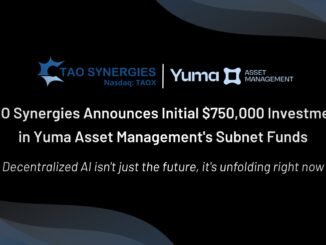
Contributor: School of Crypto
James Altucher of TAO Synergies recently joined Evan Malanga of Yuma Group for a thirty-minute conversation about Bittensor, Subnets, and the growing digital asset treasury movement. The discussion covered discovery stories, entrepreneurship, mining, alpha tokens, and the rapid rise of Bittensor as a new economic ecosystem.
This is a full breakdown of the conversation.
How Altucher Discovered Bittensor
James began by sharing his path into the world of crypto. He was early to Bitcoin, learning about it in 2013 and speaking about it frequently on CNBC and other networks. A decade later he discovered Bittensor in 2023. He studied the system, recognized its potential and wrote about it to his newsletter audience when the token traded around $48.
That discovery became the foundation for what he eventually built.
Forming a Digital Asset Treasury
The idea of a Digital Asset Treasury gained early traction through Michael Saylor’s MicroStrategy acquiring large amounts of Bitcoin. Tom Lee later launched Bitmine with a stated goal of acquiring a meaningful share of the Ethereum supply.
Once this trend became clear, people began approaching Altucher to create similar treasuries. He felt that repeating Bitcoin, Ethereum or Solana did not offer anything new. He wanted a unique asset class with stronger long term potential.
This led to the creation of TAO Synergies (TAOX), a treasury specifically focused on Bittensor.
Bittensor as an Entrepreneurship Launchpad
James and Evan explored how Bittensor lowers the barrier to building new businesses. Traditional startups require capital, staff and infrastructure. Bittensor, on the other hand, gives builders access to a global network of miners with specialized technical skills who can execute complex workloads.
This structure allows entrepreneurs to launch ideas with far less friction. Subnet owners are able to tap into talent scattered across the world, and anyone with skill can participate without institutional gatekeeping.
Ridges as a Prime Example of What Works
Altucher highlighted Ridges as a case study. Shak, the subnet owner, created an incentive structure that rewarded the miner who produced the best coding agent. Miners then competed aggressively for the prize pool, which has reached $46,000 to $100,000 per day.
This competition pushed performance to the point where Ridges now matches or exceeds companies such as Claude Code and Cursor in widely used software engineering benchmarks. It shows how Bittensor’s open environment can create results at the level of billion-dollar companies.
How Miners Fit Into the Network
James used a vivid analogy to explain miners. He described Bittensor as the Uber application and miners as the drivers. The miners who fill the most demand and provide the best service earn the most rewards.
This structure allows thousands of individuals from every background to participate. No resumes. No interviews. No insider networks. Just skill and contribution.
While traditional companies spend enormous sums recruiting a handful of elite workers, Bittensor opens the door for the entire world to contribute.
TAO Synergies and the Yuma Subnet Fund Purchase
The conversation moved to TAO Synergies’ recent collaboration with Yuma Group. They purchased $750,000 worth of both Yuma subnet funds, one modeled after a Dow Jones style basket and the other after a Nasdaq style basket.
James expressed excitement about acquiring exposure to Subnets at an early stage. He pointed to almost twenty Subnets that already match or outperform centralized competitors, yet are valued only in the tens of millions.
He also noted that holding alpha tokens yields an annual return of 60% to 100%, which compensates for their higher risk.
Building The Tao Daily as a Media Hub
Altucher then spoke about The Tao Daily, the media platform he launched to educate the community. Crypto can be difficult to understand, and Bittensor is even more complex. The Tao Daily publishes more than a dozen pieces of content per day, making it easier for newcomers and long-time community members to follow the fast-moving ecosystem.
It has quickly become a central information source for Subnet news, analysis, and ecosystem activity.
Similarities Between Bitcoin and Bittensor
The discussion closed with comparisons between Bitcoin and Bittensor. Both have identical token economics. Both launched without venture capital. Both grew through strong communities and grassroots conviction.
James explained that Bittensor essentially took Bitcoin’s incentive model and extended it. Bitcoin rewards work for hash power. Bittensor rewards work for intelligence. The principle is the same, but the output is far broader.
Final Thoughts
The conversation between James Altucher and Evan Malanga showcased how Bittensor is evolving from a single protocol into a full ecosystem with its own treasuries, entrepreneurs, miners, media and financial markets.
You can watch the complete discussion below:


Be the first to comment